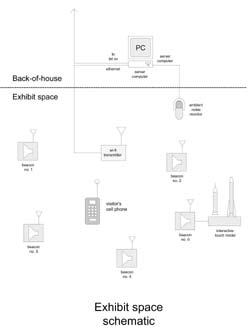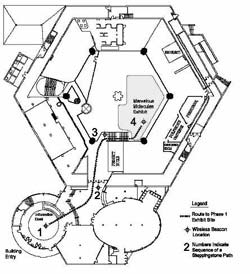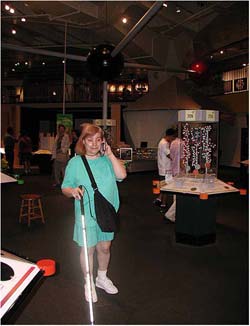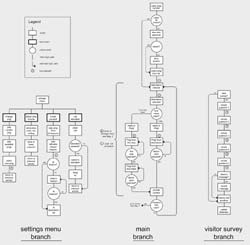Creating Accessible Science Museums with User-Activated Audio Beacons ( Ping! )
ABSTRACT
In 2003, Touch Graphics Company carried out research on a new invention that promises to improve accessibility to science museums for visitors who are visually impaired. The system, nicknamed Ping!, allows users to navigate an exhibit area, listen to audio descriptions, and interact with exhibits using a cell phone-based interface. The system relies on computer telephony, and it incorporates a network of wireless environmental audio beacons that can be triggered by users wishing to travel to destinations they choose. User testing indicates that the system is effective, both as a way-finding tool and as a means of providing accessible information on museum content. Follow-up development projects will determine if this approach can be successfully implemented in other settings, and for other user populations.
KEYWORDS
Computer telephony, blind, visually impaired, museum, accessibility, way-finding, audio description.
BACKGROUND
In 2001, Steven Landau, a sighted inventor, and Ellen Rubin , an expert in museum access who is blind, collaborated on the first concept for a network of addressable environmental audio beacons for science museums that could be controlled by blind or visually impaired museum visitors using cell phones. Inspired by the technique used in computer networking of sending out an individualized signal and listening for its echo, the inventors nicknamed the system, “ Ping! ”. In 2002, the developers were awarded a Phase 1 SBIR Grant. The project called for the installation and evaluation of a fully-functional version of the system in the New York Hall of Science (NYHoS) during the first half of 2003.
RESEARCH QUESTION
 |
For the Phase 1 feasibility test, we established a series of criteria that would have to be successfully demonstrated to justify going forward to the implementation phase:
- Could the system be made simple enough to permit individuals with a range of skills and intellectual abilities to operate the equipment with little or no prior familiarity?
- Were the sounds that were made available in the catalog of chirps, whistles and other short audio clips effective for users with varying levels of experience and potentially with some hearing loss to accurately determine the distance and direction of a sound source during travel?
- Could users travel to distant locations, by following “steppingstones” (4)? Could the computer construct an efficient route from Point A to Point B, and then guide the user along a set of way-points, providing pertinent travel warnings along the way that referred to local conditions (stairs, e.g.) that would be encountered along a travel route?
- Could more than one blind or visually impaired person simultaneously access the system and successfully navigate without becoming distracted by the actions of the other users.?
- How would the presence of potentially large numbers of other visitors, and high levels of ambient noise effect the performance of the blind or visually impaired traveler moving from one exhibit to another, and conversely, would the presence of the attractor sounds be considered annoying or distracting for members of the non-visually impaired visitor population
 |
METHOD
User trials were carried out over two weekend days in July of 2003, during normal museum hours. In four separate sessions, we brought groups of three museum visitors who were blind or visually impaired to the museum, and asked them to use the Ping! system for a period of one hour (for a total of twelve participants). The participants, recruited from local schools and organizations of visually impaired people, had been pre-qualified for the experiment through a phone survey by the Project Coordinator, which confirmed that each was at least 12 years old, knew how to operate a telephone, and was fluent in English. Out of the 12, seven were totally blind, and the remaining five had varying degrees of residual vision. The youngest participant was 15 years old and the oldest was 56. The age of onset of visual impairment ranged from birth to 30 years. One person had mild hearing loss, and one was a below-the-knee amputee. For all but one, English was their primary language, and all 12 were experienced users of touchtone phones. Prior to the actual one-hour test, participants were given a basic overview of the system. They were each issued a standard cell phone (Verizon service, Kyocera Model 2325), and were shown how to place and hang up a call.
 |
Next, the participants were brought to a designated “exhibit entry” point, and instructed to place a call to 888-338-PING, the system's toll-free phone number. For the next hour, the participants explored the museum, visiting exhibits and other destinations (restrooms, cafeteria and the main information desk). Data collection was accomplished in two ways: first, the computer automatically compiled information for each participant on the number of destinations visited, which Ping sound was selected, and the number of times that users (on average) triggered their sound during travel from one destination to the next. Then, after the one-hour exposure to the system, each user was also interviewed by project staff to ascertain impressions and recommendations for system modifications and improvements.
RESULTS
 |
Overall, the trials showed that a user-activated audio beacon system can provide way-finding information and exhibit related interpretation under naturalistic conditions. All participants were able to successfully follow their personal Ping! sounds, reach destinations they had selected, and interact with exhibit components. The presence of mainstream visitors did not adversely affect user's ability to navigate successfully. Likewise, based on observation and anecdotal evidence collected by the project staff during the test, mainstream visitors were not distracted by the beacons: they appeared to associate the Ping! sounds with the ubiquitous beeps and chirps of the interactive museum exhibits. In most cases, the Ping! sounds were audible over typical levels of ambient noise, although when large groups of children were present, some difficulties were reported by users trying to listen for their sound over the din. Users did not report feeling self-conscious; one said that, since the sounds were not coming from him, but rather emanated from the destination point, other visitors were not necessarily aware that he was responsible for making the sounds happen. Table 1 illustrates participants' assessments of how easy or difficult they found using the system.
Question |
Easy |
Both easy and difficult |
Difficult |
|---|---|---|---|
How easy or difficult did you find using the system for wayfinding? |
8 |
4 |
1 |
How easy or difficult did you find using he system for wayfinding along a “steppingstone” route? |
5 |
5 |
2 |
DISCUSSION
We tested a new strategy that takes advantage of growing ubiquity of cell phones, decreasing costs, and improvements in the service network and audio quality for calls. We demonstrated that an effective way-finding and content delivery system could be built on to the existing wireless phone network. Other researchers are investigating the use of new location-aware computer devices to provide access to text-based information about the outside environment (4). This team has chosen, instead, to rely on a simpler, more intuitive approach, that takes advantage of user's existing skills at traveling through new environments, and that does not require them to carry and learn expensive and unfamiliar hardware devices.
REFERENCES
- Kirchner, Corinne, Usable Data Report on Blindness and Visual Impairment, Journal for Visual Impairment and Blindness, January 1999.
- Friedman, Alan (2000). Expanding audiences: the audio tour access project at the New York Hall of Science. ASTC Dimensions . Association of Science and Technology Centers, Jul./Aug., 2000.
- Fruchterman, James. In the Palm of Your Hand: A vision of the future of technology for people with visual impairments. Journal of Visual Impairment and Blindness. October 2003.
- May, Michael (2003). Accessible GPS for the blind: what are the current and future frontiers? In Proceedings of the 2003 CSUN Conference. California State University Northbridge, 2003.
ACKNOWLEDGMENTS
This study was funded by an NSF Phase 1 Small Business Inovation Research Grant.
Author Contact Information:
Steven Landau, M.Arch,
Touch Graphics Company,
330 West 38
Street Suite 1204,
NY 10018,
office phone: 646-515-3492,
email:
sl@touchgraphics.com
